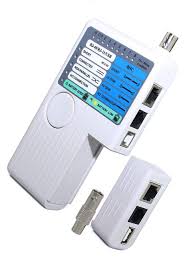A remote cable tester for USB and LAN cables is a device used to test the integrity and functionality of USB and LAN (Local Area Network) cables. It typically consists of two main components: a master unit and a remote unit.
Here's how it works:
1. **Master Unit:** The master unit is the main control unit of the tester. It is connected to one end of the cable that needs to be tested. This unit sends signals through the cable and receives feedback from the remote unit.
2. **Remote Unit:** The remote unit is attached to the other end of the cable being tested. It receives signals from the master unit and sends feedback back to the master unit. The remote unit is usually smaller and more compact than the master unit, making it easier to attach to the cable.
3. **Testing:** The master unit sends signals through the cable to test various parameters such as continuity, wiring faults, signal strength, and data transmission capabilities. The remote unit receives these signals and sends feedback back to the master unit, indicating whether the cable passed or failed the test.
4. **Feedback:** The master unit typically provides feedback to the user through visual indicators such as LED lights or an LCD display. It indicates whether the cable passed or failed the test and may also provide additional information about any detected faults.
5. **Compatibility:** A remote cable tester for USB and LAN cables should be compatible with various types of USB and LAN cables, including different USB standards (such as USB 2.0 and USB 3.0) and Ethernet cables (such as CAT5e and CAT6).
Overall, a remote cable tester for USB and LAN cables is a valuable tool for network technicians, IT professionals, and anyone else who needs to quickly and accurately test the integrity of USB and LAN cables in various networking and data transmission applications.
